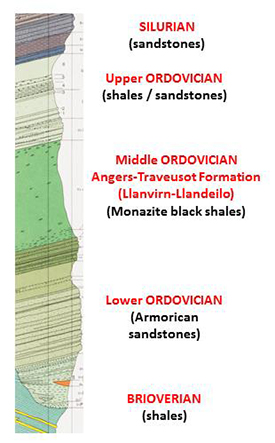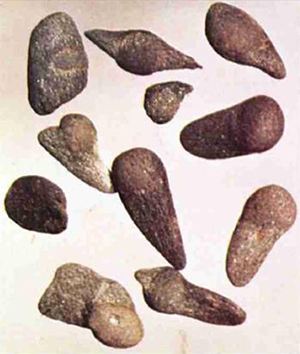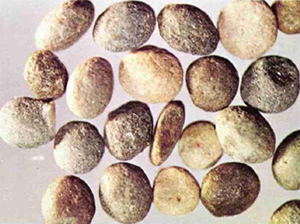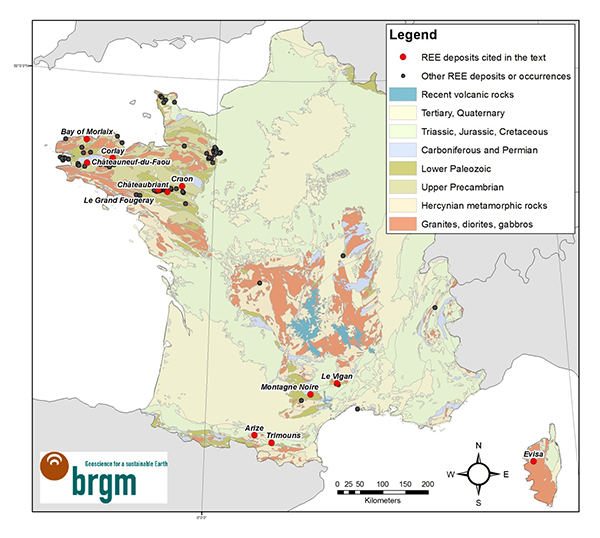REE mineralisation in France
Relatively few REE occurrences are known in France, although the presence of alkaline magmatism in the Massif Central, the Pyrenées and Corsica raises the possibility that further occurrences remain to be discovered. Presently, the only relatively well documented REE deposits are monazite nodules of detrital origin in shales from Central Brittany.
Placers of Brittany
The most significant REE enrichments are located in low grade metamorphosed black shales of Dinantian (Châteauneuf-du-Faou, Corlay) or Ordovician age (le Grand-Fougeray, Châteaubriand), and may also be found in Neoproterozoic basement adjacent to the Ordovician series (Craon). These shales commonly contain 50 to 200 g/t of monazite nodules. However, from an economic point of view, only placers where these nodules have been concentrated are likely to be of interest.
Le Grand-Fougeray Placer

Le Grand-Fougeray monazite placer, derived from shales of the Ordovician Traveusot Formation, is the largest and the best documented of the placers in Brittany. Estimated tonnages in alluvium of the Aron and Gras rivers are modest (1900 t of monazite in clayey gravels with a grade of 2 to 2.6 kg of monazite per ton, and a cut-off at 1 kg/t). However, this monazite is exceptionally rich in europium (0.2 to 1 per cent Eu2O3); it also contains neodymium (13 to 14 per cent Nd2O3) and is poor in thorium (<1 per cent ThO2).
Exploitation tests were carried out at a site in the Aron river in 1967–1968, and 78 tons of monazite were extracted and marketed. New analyses have indicated interesting grades in dysprosium (0.25 per cent Dy) and terbium (0.1 per cent Tb).


Other occurrences
Similar layers of shales with monazite nodules and associated placers, but of lesser interest, are also known in the Mayenne region in the southern Massif Central, in the Ardennes and in the French Pyrenées (Arize massif) (Lacomme et al., 1993). Interesting sedimentary occurrences include Le Vigan, in the Cévennes, where Cambrian dolomites contain thick but discontinuous phosphate-enriched layers with 0.1–0.22 per cent uranium, 0.1–0.18 per cent thorium and 0.17–0.25 per cent REE. In the Montagne Noire, approximately 30 cm thick layers of limestone and black shale are intercalated within Cambrian fine-grained detrital marine sediments, and contain clasts and phosphate-enriched nodules with 5–20 parts per million (ppm) thorium, 10–40 ppm uranium and 0.03–0.21 per cent REE (Laval et al., 1990).
The majority of other known REE occurrences in France are of mineralogical interest rather than having likely resource potential (Massif Central, Armorican Massif, Estérel, Pyrenées). The Trimouns deposit at Luzenac in the central Pyrenées is a world-class talc deposit, where bastnäsite and several rare earth minerals have been described. Disseminated occurrences of rare earth minerals are also known in various intrusive complexes (syenites in the bay of Morlaix in Brittany, alkaline granite of the Evisa region in Corsica) and volcanic formations (e.g., Cantal).
Key references
Donnot, M, Guigues, J, Lulzac, Y, Magnien, A, Parfenoff, A, and Picot, P. 1973. Un nouveau type de gisement d'europium : la monazite grise á europium en nodules dans les schistes paléozoïques de Bretagne. Mineralium Deposita (in French), 8, 7–18.
Guigues, J, and Devismes, P. 1969. La prospection minière á la batée dans le Massif Armoricain : méthodes, résultats, atlas minéralogique. Mémoire du BRGM No. 71 (in French) 167 p.
Lacomme, A, Hottin, A-M, and Laval, M. 1993. La monazite grise du massif de l'Arize (Pyrénées françaises). Report BRGM R 37041 GEO-SGN 93 (in French), 48 p.
Laval, M, Prian, J-P, Hottin, A-M, and Orgeval, J-J. 1990. Les terres rares dans les formations cambriennes des Cévennes et de la Montagne Noire (Massif central français). Report BRGM R31672 DEX-DAM-90 (in French), 40 p.

